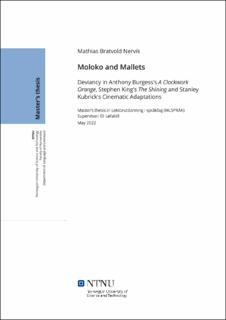| dc.description.abstract | This thesis examines the topic of deviancy in Anthony Burgess’s "A Clockwork Orange" (1962) and Stephen King’s "The Shining" (1977), as well as how this theme finds expression in Stanley Kubrick’s adaptations of these novels. The analyses primarily focus on the deviant characters of the works and how the creation of tone and the utilization of medium-specific elements underpin different representations of deviancy. The thesis finds that the use of the fictional argot “Nadsat” in Burgess’s "A Clockwork Orange" affects the way in which violence and other forms of deviant behavior are experienced by the reader, while the mise-en-scène and the auditory elements of Kubrick’s adaptation serve similar functions with regard to its representation of deviancy. These cinematic devices are also identified as important in Kubrick’s adaptation of "The Shining", wherein the film’s depiction of Jack Torrance, which differs significantly from that of the novel, presents wider implications for the portrayal of deviancy. The text concludes that Kubrick’s adaptations of the novels, via cinema-specific measures, and especially through their endings, suggest a more bleak and pessimistic view on the notion of deviancy than those of the novels. | |
